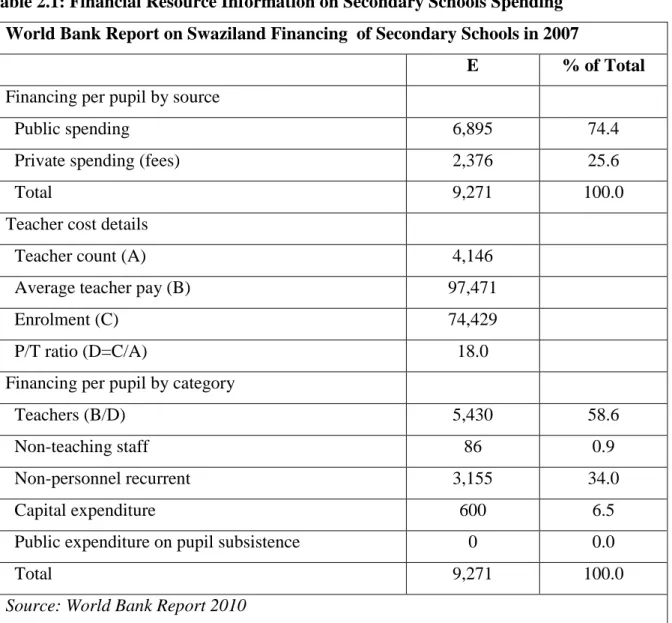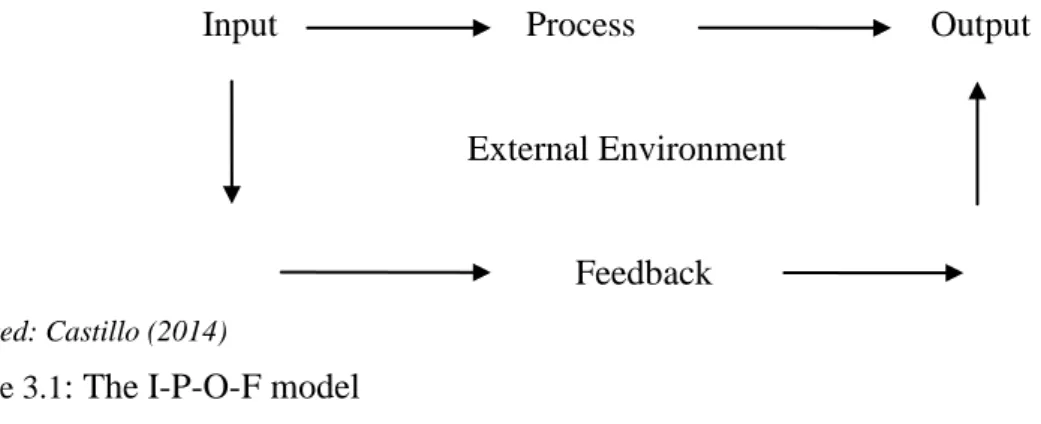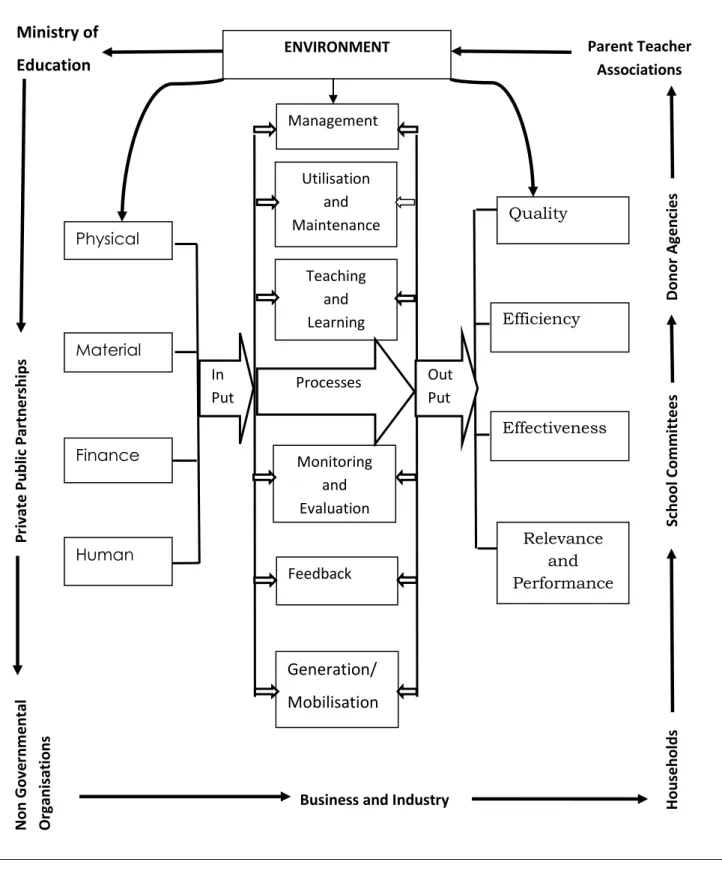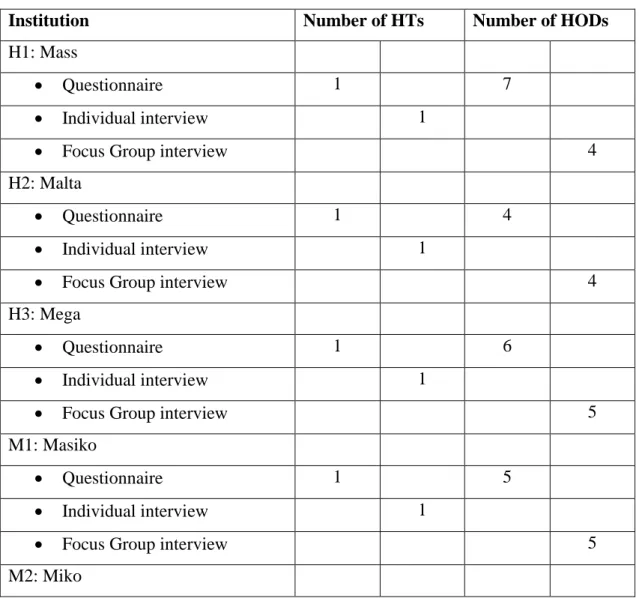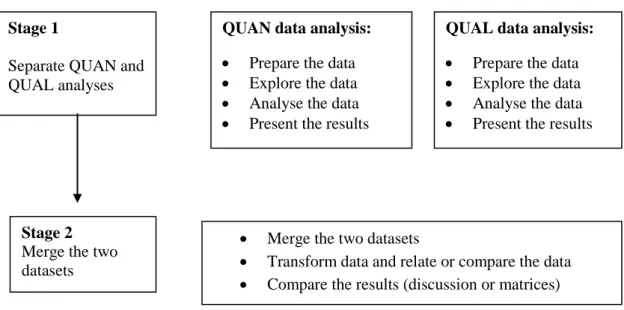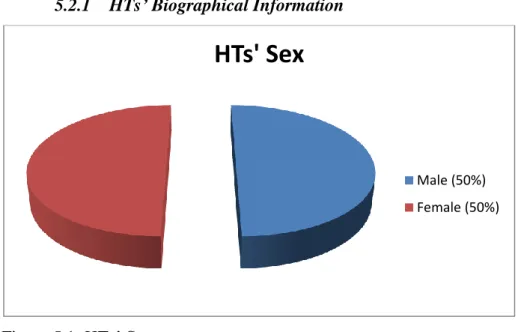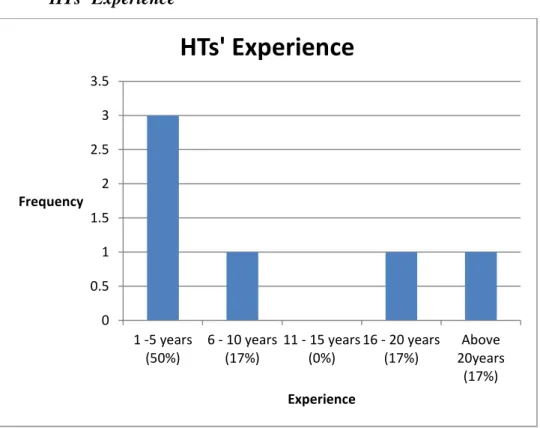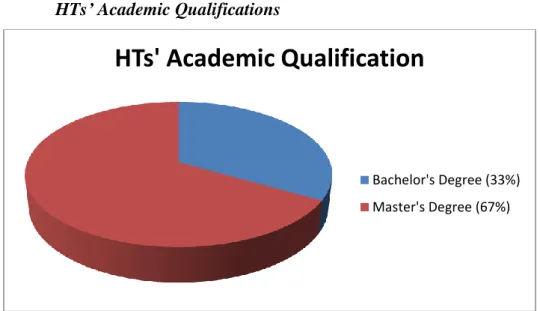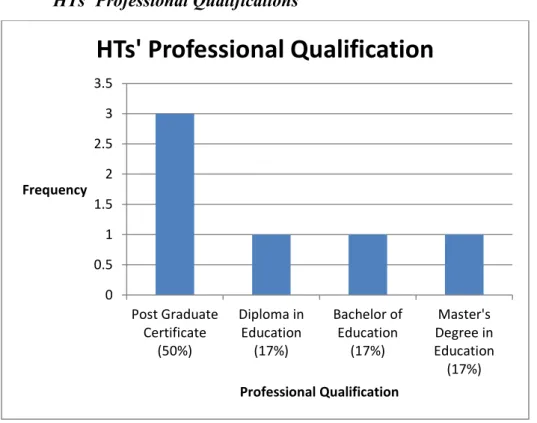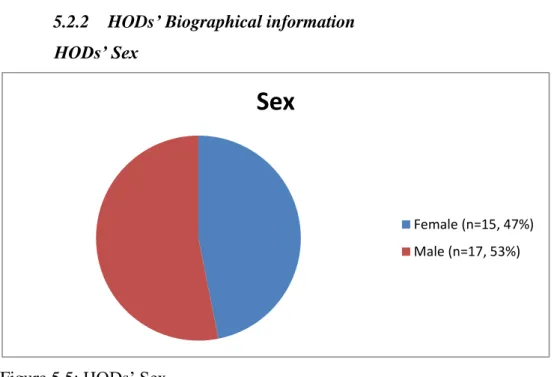THE DYANAMICS OF GENERATING AND MANAGING EDUCATIONAL RESOURCES IN SWAZILAND SELECTED
SECONDARY SCHOOLS
DORIS NOMPUMELELO LANGWENYA-MYENI
Submitted in Fulfilment of the Requirements for the Degree of
Doctor of Philosophy
Educational Leadership, Management and Policy School of Education
UNIVERSITY OF KWAZULU-NATAL Edgewood Campus
Durban, South Africa
Supervisor
PROFESSOR VITALLIS CHIKOKO
2017
ii
SUPERVISOR’S AUTHORISATION
As the candidate‟s Supervisor, I agree to the submission of this thesis.
Prof. Vitallis Chikoko
Signed: _________________________ Date: ___________________
iii
DECLARATION
I do declare that:
1. The research reported in this thesis except where otherwise indicated, is my original work.
2. This thesis has not been submitted by any degree or examination at any other university.
3. This thesis does not contain other persons‟ data, pictures, graphs, or other information, unless specifically acknowledged as being sourced from other persons.
4. This thesis does not contain other persons‟ writings unless specifically acknowledged as being sourced from other researchers. Where other written sources have been quoted, then:
4.1. Their words have been re-written but the general information attributed to them has been referenced.
4.2. Where their exact words have been used, their writing has been placed inside quotation marks and referenced.
5. Where I have reproduced a publication of which I am author, co-author or editor, I have indicated in detail which part of the publication was actually written by myself alone and have fully referenced such publications.
6. This thesis does not contain text, graphics or tables copied and pasted from the internet, unless specifically acknowledged, and the source being detailed in the thesis and in the reference section.
Signed: ______________________ Date: _______________________
iv
ETHICAL CLEARANCE CERTIFICATE
v
DEDICATION
This research work is dedicated to my Master Jesus Christ, from whom all good things come.
Dedications also go to my late parents, Reverend Richard M. Langwenya and Mrs. Vinah P.
Langwenya for their strong character, being disciplinarians. They taught us generosity, forgiveness, a passion to study the Bible and taught us how to appreciate the importance of individuality. They were my role models, mentors, hard workers, encouragement, dedicated in serving the Lord and always supportive in my endeavours. May their souls rest in peace, wonderful sweet parents.
vi
ACKNOWLEDGEMENTS
For the completion of this milestone in my education career, I would like to extent my appreciation to which I am indebted, with heartfelt thanks to the Almighty God. He is the one who through His unfailing love, grace, mercies and favour made all this possible. The following people in my life whose motivation, encouragement, enormous support and personal sacrifices made this research study possible, I ask the Lord Almighty to bless them abundantly.
I would like to appreciate, my project promoter, inspirer, supervisor, motivator, challenge and mentor, Professor Vitallis Chikoko. He gave me his professional guidance, unrelenting wisdom, constructive critiques; and his passion for research resulted to thought provoking, fruitful discussions as well as his patience, time and tolerance throughout the research period.
He emerged as an igniter in time of hardship; he built confidence in me and taught me that belief and perseverance were the key building blocks of a successful career such as this.
My colleagues at NCC, especially my HOD, Mr Torch Dlamini for his honest critique and for allowing me time to meet with my supervisor to work on the study. My husband, my friend, John Vusi Myeni for his love, patience, understanding and tolerance while carrying out this project. My children Musawenkhosi Phillip Myeni and Siphosemusa Predestinate Myeni for their loving, supportive, encouragement and prayers tendered over the years of my studies.
The Head Teachers and Heads of Departments who allowed me access to their schools and agreed to complete the questionnaire and attended interviews while I was doing my research.
The voluminous data I gathered was largely as a result of their participation and willingness to be part of this study. To all those and several others unnamed, I say: I owe it all to you. This is your accomplishment, as well.
My colleagues and students, whom I taught between 1995 and 2012, in return these boosted me to be zealous, have a positive self concept and a high self-esteem.
vii
ABSTRACT
In this study I investigated the dynamics of generating and managing educational resources in Swaziland secondary schools. The need for this study arose out of my realisation of a knowledge gap namely the inefficiency in physical and material resource distribution, high secondary school costs of education and financial resource mismanagement in schools. In the study I explored the experiences of Head Teachers (HTs) and Heads of Departments (HODs);
factors affecting educational resources; and practices to sustain educational resources generation and management. I employed a mixed methods research approach using a multiple- site case study design. I purposively selected six government secondary schools with six HTs and thirty two HODs as participants of the study, in two regions of Swaziland. I generated data through a questionnaire, face-to-face interviews, focus group interviews and document analysis. Qualitative data were analysed by means of descriptive statistics. Qualitative data were analysed through thematic analysis. I adopted a three-pronged theoretical framework involving the collegiality theory of management, the systems approach and funding models.
Findings revealed that while the schools had the basic resources, some of these were obsolete and others needed immediate repair. Although schools seemed to have the potential of linking with the external environment, resource generation therein was currently inward looking and very limited in terms of expansion strategies. The schools did not have structures in place for resource mobilisation and management. There was an apparent absence of clear policy guidelines on resource activities, no strategic planning conducted with the external world and school managers (HTs and HODs) seemed to lack skills and techniques for generating and managing educational resources. I conclude that the schools need to improve upon their internal mechanisms to manage existing resources. I further conclude that the current inwards looking approach to resource generation is unsustainable. Schools need to forge partnerships at two main levels: with other schools and with the broader community.
viii
TABLE OF CONTENTS
SUPERVISOR‟S AUTHORISATION ... ii
DECLARATION ... iii
ETHICAL CLEARANCE CERTIFICATE ... iv
DEDICATION ... v
ACKNOWLEDGEMENTS ... vi
ABSTRACT ... vii
TABLE OF CONTENTS ... viii
LIST OF TABLES ... xii
LIST OF FIGURES ... xiii
ACRONYMS ... xv
1. CHAPTER ONE: OVERVIEW OF THE STUDY ... 1
1.1 Introduction ... 1
1.2 Background to the Study ... 2
1.3 Statement of the Problem ... 7
1.4 Research Questions... 11
1.5 Significance of the study ... 11
1.6 Clarification of Terms ... 12
1.7 Overview of the Report ... 13
2. CHAPTER TWO: LITERATURE REVIEW ... 15
2.1 Introduction ... 15
2.2 Examining Key Concepts ... 15
2.2.1 Management ... 15
2.2.2 Resources ... 20
2.2.3 Physical Resources ... 23
2.2.4 Material Resources ... 26
2.2.5 Generating or Mobilising Resources ... 28
2.2.6 Efficiency ... 29
2.2.7 Effectiveness ... 31
2.3 Resource Provision in Swaziland Schools... 32
2.4 Some Relevant Studies and their Implications ... 35
ix
2.5 Generating Resources in Organisations ... 42
2.5.1 Resource Mobilisation in Organisations... 42
2.5.2 Factors Hindering Resource Mobilisation ... 44
2.5.3 Resource Mobilisation Strategies ... 45
2.5.4 Some Relevant Theories of Resource Mobilisation in Education Management ... 46
2.6 Managing Resources in Organisations ... 48
2.6.1 Management Skills ... 48
2.6.2 Some Principles and Strategies of Resource Management ... 49
2.6.3 Resource Maintenance and Sustainability ... 52
2.6.4 Factors Hindering Resource Management ... 56
2.6.5 Some Theories in Resource Management ... 60
2.7 Emerging Issues ... 62
3. CHAPTER THREE: THEORETICAL FRAMEWORK ... 66
3.1 Introduction ... 66
3.2 The Importance and Role of Theory in Management and Research ... 66
3.3 The collegial Model of Educational Management ... 67
3.3.1 Features and Advantages of Collegial Models ... 67
3.3.2 Some Disadvantages of Collegial Models ... 69
3.4 The Systems Theory ... 70
3.4.1 Features of the Systems Theory ... 72
3.4.2 Some Advantages of the Systems Model ... 75
3.4.3 Some Disadvantages of the Systems Model ... 75
3.5 Funding Models ... 76
3.5.1 Downes (2007) Potential Funding Models ... 78
3.5.2 Wiley (2007) Potential Funding models ... 79
3.6 Integrating the Models of Resource Mobilisation and Management ... 81
3.7 Conclusion ... 85
4. CHAPTER FOUR: RESEARCH DESIGN AND METHODOLOGY ... 87
4.1 Introduction ... 87
4.2 Research Paradigm ... 87
4.3 Research Design ... 89
4.4 RESEARCH METHODOLOGY ... 93
x
4.4.1 Delimitations of the Study ... 93
4.4.2 Participants ... 94
4.4.3 Data Generation Instruments ... 96
4.4.4 The Pilot Test ... 101
4.4.5 Triangulation Strategy... 102
4.4.6 Data Generation Procedures... 102
4.4.7 Data Analysis Procedures ... 103
4.5 Ethical Considerations ... 105
4.5.1 Informed Consent and Voluntary Participation ... 106
4.5.2 Protection from Harm ... 106
4.5.3 Privacy, Confidentiality and Anonymity ... 106
4.6 Trustworthiness ... 107
4.7 Conclusion ... 108
5. CHAPTER FIVE: DATA PRESENTATION AND DISCUSSION ... 109
5.1 Introduction ... 109
5.2 HTs and HODs Biographical information ... 110
5.2.1 HTs‟ Biographical Information ... 110
5.2.2 HODs‟ Biographical information... 112
5.2.3 Staff Compliment and Enrolment in the Schools... 115
5.3 Theme One: Perspectives on Sourcing of Resources ... 115
5.3.1 HTs‟ Perspectives on Sourcing Resources... 116
5.3.2 HODs‟ Perspectives on Sourcing Resources ... 117
5.4 Theme Two: Availability, Adequacy and Management of Resources ... 119
5.4.1 HTs Perceptions on Resource Availability ... 119
5.4.3 HTs‟ Perspectives on Maintenance of Resources ... 125
5.4.4 HODs Perspectives on Maintenance of Resources ... 126
5.5 Theme Three: Factors Influencing Resource Generation and Management ... 130
5.5.1 HTs Perspectives on Enablers to Resource Management ... 130
5.5.2 HODs Perspectives on Enablers for Resource Management ... 132
xi
5.5.3 HTs Perspectives on Factors Hindering Resource Generation and Management . 135 5.5.4 HODs Perspectives on Factors Inhibiting Resource Generation and Management
138
5.6 Theme Four: Sustainable Practices in Resource Generation and Management ... 143
5.6.1 HTs Sustainable Practices in Generating Resources ... 143
5.6.2 HTs Sustainable Practices in Managing Resources ... 144
5.6.3 HODs Perceptions in Resource Sustainable Practices ... 148
5.7 Conclusion ... 153
6. CHAPTER SIX: PROBLEMATISING THE NOTION OF “SUSTAINABLE GENERATION AND MANAGEMENT OF EDUCATIONAL RESOURCES”... 155
6.1 Introduction ... 155
6.2 Looking Back ... 155
6.3 Crystallising the Findings ... 158
6.3.1 Perspectives about Sourcing Educational Resources ... 159
6.3.2 Availability, Supply and Maintenance of Resources ... 160
6.3.3 Factors Influencing Resource Generation and Management ... 161
6.3.4 Sustainable Practices in Resource Generation and Management ... 162
6.4 Suggestions for Further Research ... 171
6.5 Limitations of the Study ... 171
6.6 Ending the Research Journey ... 172
REFERENCES ... 173
APPENDICES ... 192
xii
LIST OF TABLES
Table 2.1: Financial Resource Information on Secondary Schools Spending ... 33
Table 4.1: Participants of the study... 95
Table 5.1: Staff Complement and Enrolments in the Schools ... 115
Table 5.2: HTs Responses on Sourcing Educational Resources ... 116
Table 5.3: HODs Responses on Sources of Educational Resources ... 117
Table 5.4: Availability of Resources as Indicated by HTs ... 120
Table 5.5: HTs‟ views on the Supply of Teaching and Learning Resources ... 122
Table 5.6: Adequacy of Maintaining Resources as rated by HTs ... 125
Table 5.7: HODs‟ Perspectives on Resource Maintenance ... 126
Table 5.8: Enabling Factors in Resource Generation and Management as rated by HTs ... 130
Table 5.9: Challenges in Resource Generation and Management as Perceived by HTs ... 135
Table 5.10: Challenges in Resource Generation and Management and Rated by HODs ... 138
Table 5.11: HTs Views on Sustainable Practises in Generating Resources ... 143
Table 5.12: HTs Views on Sustainable Practices in Managing Resource ... 144
Table 5.13: HODs Views on Sustainable Practices in Resource Generation and Management ... 148
xiii
LIST OF FIGURES
Figure 3.1: The I-P-O-F model ... 74
Figure 3.2: Conceptual framework to the study... 83
Figure 3.3: Theoretical Model of the Study ... 84
Figure 4.1: Concurrent Triangulation Data Analysis Procedure ... 105
Figure 5.1: HTs‟ Sex ... 110
Figure 5.2: HTs‟ Experience as Heads of School ... 111
Figure 5.3: Highest Academic Qualifications of HTs ... 111
Figure 5.4: HTs‟ Professional Qualifications ... 112
Figure 5.5: HODs‟ Sex ... 112
Figure 5.6: HODs‟ Experience as Leaders in their Departments... 113
Figure 5.7: HODs Highest Academic Qualifications ... 114
Figure 5.8: HODs‟ Professional Qualifications ... 114
Figure 6.1: Factors Influencing Resource Generation and Management and Sustainable Practices for Resources ... 170
xiv
LIST OF APPENDICES
APPENDIX 1: PERMISSION LETTER FROM MOET ... 193
APPENDIX 2: GATE KEEPERS‟ LETTER ... 194
APPENDIX 3: PERMISSION LETTER FROM MANGO SCHOOL ... 196
APPENDIX 4: PERMISSION LETTER FROM MASIKO SCHOOL ... 197
APPENDIX 5: PERMISSION LETTER FROM MEGA SCHOOL ... 198
APPENDIX 6: PERMISSION LETTER FROM MIKO SCHOOL ... 199
APPENDIX 7: PERMISSION LETTER FROM MALTA SCHOOL ... 200
APPENDIX 8: PERMISSION LETTER FROM MASS SCHOOL ... 201
APPENDIX 9: ETHICAL CLEARANCE CERTIFICATE ... 202
APPENDIX 10: LETTER OF CONSENT ... 203
APPENDIX 11: LETTER OF VALIDATION FOR QUESTIONNAIRE ... 206
APPENDIX 12: QUESTIONNAIRE FOR HEAD TEACHERS ... 210
APPENDIX 13: INTERVIEW SCHEDULE FOR SCHOOL PRINCIPALS ... 218
APPENDIX 14: SSP DOCUMENT ANALYSIS SCHEDULE ... 219
APPENDIX 15: QUESTIONNAIRE FOR HODs OF SCHOOLS ... 221
APPENDIX 16: FOCUS GROUP INTERVIEW SCHEDULE FOR HODs ... 228
APPENDIX 17: STOCK BOOK DOCUMENT ANALYSIS SCHEDULE ... 229
APPENDIX 18: HTs INTERVIEW TRANSCRIPT RESPONSES ... 230
APPENDIX 19: HODs FGI TRANSCRIPT RESPONSES ... 246
xv
ACRONYMS
CEO Chief Executive Officer EDSEC Education and Training Sector
EFA Education for All
EMIS Education Management Information System EMS Environmental Management System
ESSP Education Sector Strategic Plan
ETSDS Education, Training and Skills Development Sector FDI Foreign Direct Investments
FGI Focus Group interviews FPE Free Primary Education GEA Global Education for All GDP Gross Domestic Product GER Gross Enrolment Ratio
GET General Education and Training HDI Human Development Index HOD Head of Department
HSSREC Humanities and Social Sciences Research Ethics Committee
HT Head Teacher
ICT Information Communication Technology ILO International labour organisation
IPOF Input Process Output Feedback LMIC Low Middle Income Countries MBO Management By Objectives MDG Millennium Development Goals MoET Ministry of Education and Training NCC National Curriculum Centre
NEP National Education Policy
NETIP National Education and Training Improvement Programme NGO Non Government Organisations
NPS National Policy Statement
NVCO National Council for Voluntary Organisations
xvi OVC Orphan and Vulnerable Children PAC Public Accounts Committee
POLCCC Plan, Organise, Lead, Coordinate, Control, and Command PTA Parent Teacher Association
RDT Resource Dependence Theory RMT Resource Mobilisation Theory REO Regional Education Officer SBM School Based Management
SDENR Swaziland Development of Education National Report SMO Social Movement Organisations
SGRP School Guide Regulation Procedures SNL Swazi Nation Land
SSP School Strategic Plan
TSC Teaching Service Commission UBE Universal Basic Education UN United Nations
UPE Universal Primary Education
WB World Bank
1
1. CHAPTER ONE: OVERVIEW OF THE STUDY
1.1 Introduction
In this study I set out to investigate how educational resources were generated and managed in selected Swaziland secondary schools. In this chapter I describe the research problem and its setting. To achieve the goal I begin by presenting the background to the study. From there I move on to explore the challenges and factors that affect educational resources generation and management. Next I discuss the statement of the problem followed by the research questions, the significance of the study and the definition of key terms. In the final section I give an outline of the research report.
I have spent some time in teaching learners at secondary school level and took up a Head of Department (HOD) position in the process. My department was not performing up to the expected standard until I realised that it lacked some of the appropriate teaching and learning materials and tools that had had a bearing on learners‟ academic performance. The department moved the overall external examination results from about 40 percent to 100 percent pass rate in the eight years that I served in that secondary school. In the process of improving the results, we were provided with all required teaching and learning materials and our work was made a lot easier. I assumed a position of a Curriculum Designer, at the National Curriculum Centre (NCC) which is also a wing of the Ministry of Education and Training (MoET). Looking at government‟s provision and distribution of teaching and learning materials, I became curious in knowing whether there was proper guidance to the management of these facilities. I became interested in knowing more about how schools went about generating these resources for the continuity of education. It is my passion to know whether the goals of education in the country are being achieved and the extent to which resources are taken care of in schools as an Economist. My ultimate vision was to establish whether there are guiding principles regarding the management, provision and monitoring of resources in schools. I was also interested in understanding the factors affecting the mobilisation and maintenance of resources in schools.
Therefore, this is what brought about my interest about this study.
2 1.2 Background to the Study
At independence in 1968, one of the aims of the government of Swaziland was to expand the availability of physical space in the school system following restrictions of the previous governments (National Policy Statement (NPS), 1999). Therefore, educational services and facilities were significantly expanded. Thus Universal Primary Education (UPE), that is, access of every primary school-going age child was attained in 1985. So, government efforts nowadays have shifted to addressing issues such as quality, relevance and affordability of the education. The ultimate goal is that graduates of the education system should contribute to the development of the country‟s economy (NPS, 1999).
The National Education Policy (NEP) (1999) and Education and Training Sector (EDSEC) Policy (2011) identify the Swaziland government‟s challenges at secondary school level of education. These include low and inequitable access, limited pathways, low relevance, internally inefficient, unaffordable costs and poor management. Further, the country lacks quality and quantity of secondary education to support its growth strategy. In terms of access the World Bank (WB) report (2010) found that current access levels in the country were low and not responsive to the demand for skills required to a sustainable economic development.
With regard to enrolment the National Education and Training Improvement Programme (NETIP) (2013) shows that there is low access to secondary education. It indicates a net enrolment ratio of 33% for 2010. It points to low physical capacity at secondary level with poor infrastructure, classrooms, laboratories, workshops, furniture, water, electricity, sanitation, and sporting facilities in Swaziland schools (NETIP, 2013). Coming on to inequalities NETIP (2013) reports that inequalities of education access, inputs and outcomes result to difficulties for the country to use the Education, Training and Skills Development Sector (ETSDS) as they are thought to be the powerful equalisers. Therefore, government had to adopt a balanced expansion of access to all levels of the ETSDS. This is where by all learners disregarding the parents‟ income levels have full access to the same kind and level of education. Therefore, there is need for qualified teachers, appropriate infrastructure and material resources without any of them being limited by financial constraints.
With regards to efficiency in the education subsector, NETIP (2013) indicates that completion rates are low and years-input per graduate are too high. Concerning school books there is lack of a book policy thus management of secondary school book provision varies widely across
3
schools. A combined cost of textbooks, exercise books and stationery could be very high, exceeding 5000 Emalangeni (E5000) per year.
Secondary education provides a vital link between primary education and the world of work and further training. The Swaziland Development of Education National Report (2008) views education as the cornerstone for sustainable economic and social development of any country.
Education and training is also known to be the panacea to most economic and social ills world over. Even many countries in the world view education as a good investment for personal, national and economic growth (Olatoun, 2012; Oluwadare, 2011; Sigilai, 2013). Therefore, this is an important sub-sector in the preparation of human capital development and provision of life opportunities (Sigilai, 2013; & World Bank Group, 2013). Asiabaka (2008) stresses that the quality of education that learners receive bears direct relevance to the availability or lack thereof of educational resources and the overall atmosphere in which learning and teaching take place. This means that accessibility and adequacy of resources and equipment in schools is a serious matter to educators. It is also in view of the indispensable role of education in the development of humans and the society that various declarations in education have been made at global level and in Swaziland.
Afolabi, Oyewusi and Ajayi (2008) suggest that the most effective way of sustaining education at secondary school level is the provision of adequate physical and material resources. This assumes that education in secondary schools can be effectively sustained if all schools are well resourced financially. Afolabi et al., (2009) also succinctly put it that the success of a secondary school depends on the resources available to it. So, there is need for improved quality of services in education through improved management of resources by schools, and efficient utilisation of resources leading to improved achievement of curriculum objectives.
The World Bank (WB) Group (2013) holds that secondary education is a gateway to opportunities and benefits of economic and social development. Demand for access to higher levels of education grows drastically as countries approach universal primary education (UPE).
Also, the global education for all (EFA) effort provides added momentum for the growth of secondary education. Further, globalisation and the increasing demand for a more sophisticated labour force combined with the growth of knowledge-based economies gives a sense of urgency to the heightened demand for secondary education. Consequently, secondary education is now being recognised as the cornerstone of educational systems in the 21st century. So, quality secondary education is indispensable in creating a bright future for
4
individuals and nations alike (WB Group, 2013). The WB Group (2013) also suggests that a cost recovery accompanied by encouragement of private and community schools can improve quality and efficiency in education for countries. There, a more holistic approach to secondary education is advocated for, rather than one which focuses on vocational education. In countries with low secondary education enrolment, the WB Group (2013) suggests that focus should be on: a) meeting specific shortages of educated manpower in the public and private sectors by raising secondary school completion rates and b) improving the social conditions of the poor and reducing inequality by expanding access to secondary education (WB group, 2013). This implies that it is imperative to invest in secondary school education and to furnish schools with sufficient resources that can sustain them to help achieve the county‟s development goals.
According to the EDESEC policy (2011) the government of Swaziland aims to provide interventions for educational resources in secondary schools like libraries, laboratories and textbooks to enhance the achievement of educational goals and objectives. Similarly, the WB Group (2013) suggests four factors that promote a rapid increase in the share of lending to General Secondary Education (GSE). a) The demand for secondary places has grown as primary completion has risen. b) The equitable and sustainable financing and management of secondary education becomes a challenge, especially in low-income countries. c) The role of secondary education in economic and social development is re-assessed in the context of globalisation and competitiveness. d) Changes in secondary education are driven by rapid transformations in technology and labour force markets. Seemingly, secondary education has been neglected in developing and financing education systems nevertheless, today its vital importance cannot be ignored. In addition, secondary education systems everywhere will need to be more flexible, relevant and responsive to both local needs and the global environment in the 21st century (WB Group, 2013). This means that policy makers, managers and educators need to address the challenges of increasing access, quality and relevance of secondary education for all young people.
According to the School Guide Regulation Procedures (SGRP) (1978) school leaders/Head Teachers (HT) are responsible for the supervision and control of the work of teachers and learners. They need to provide professional guidance, support and advisory services. They should ensure that the school is conducted in accordance with the procedures. In order to do the work effectively, the administrators must attend conscientiously all matters which are connected with planning, recording done by the teachers and the quality and quantity of written
5
work done by pupils (School Guide Regulation Procedures, 1978). Gibson, Ivancevich, Donnelly and Konopaske (2006) also emphasise that the chief executive officer (CEO) has to plan, organise, command, co-ordinate, lead and control school operations. In relation to school administration a manager is expected to carry out the following administrative tasks:
curriculum and instruction, finance and business administration, physical facilities, school- community relations and personnel (Waweru, 2004). The school administrators‟ effectiveness and efficiency in their administrative roles in school leadership would be determined according to good leadership, which is the ability to vary leadership styles according to the needs of the situation, action oriented and being visionary. Therefore the administrator has to display excellent communication skills, have self confidence and be able to take risks. The school administrator motivates staff and learners in the school, has high integrity, able to generate loyalty and a good team builder. They must be well informed in many fields such as government policies on education, traditions and practices of the school's neighbouring community. They also have thorough knowledge of school, educational operations of such documents as the Education Act and teaching service commission (TSC) code of regulations for teachers (Waweru, 2004).
However, the reality on the ground is that administrators in schools do not always score highly when graded for their performances due to challenges they encounter in their work place that are not necessarily as a result of their own making. This suggests that there is a need to improve planning, coordination and management of resources in schools. Waweru (2004) and Gibson et al., (2006) observe that education management is the most fundamental and precious capacity resource that is required in all educational organisations. Therefore, it is important that education should be managed by various offices and bodies with clearly defined roles to avoid conflicts and confusion. It is also important that proper management of the national education goals regarding access, resource management and enrolment are realised sooner to achieve the country‟s vision 2022. Fasasi (2011) refers to management of secondary schools as a process of making use of the available resources towards the achievement of an education goal. This means, the head of a school and their staff have the administrative responsibilities of directing available resources towards actualisation of the goals of education. They plan classrooms and out-of-classroom activities for teachers and learners. They also co-ordinate the school activities in order to ensure that many programmes go on at the same time without one conflicting with others (Fasasi, 2011). Specifically the school manger develops personnel; improve instructional programmes and learners‟ personnel services. They also should ensure the maintenance of
6
effective interrelationship with the community and external agencies of the school (Ada &
Ada, 2013). It is crucial therefore, that no matter how well a school is equipped, how relevant the school curriculum is, how well the physical resources a school has and how much money the stakeholders are ready to invest in education, but without proper management of these resources it may be difficult to realise efficiency and effectiveness in schools.
The WB report (2010) noted that Swaziland education management information system (EMIS) unlike its neighbouring countries Namibia and South Africa does not routinely capture the state of provision in the physical teaching and learning environment and the extent to which it may affect teaching and learning. Lack of accurate information of such provisions makes it very difficult to plan for provision and to track equity in provision. According to the WB report (2010) school inspectors‟ reports for the period 2004 to 2008 had documented poor maintenance and up-keep of school infrastructure. The reports showed that there was severe shortage of school furniture. Available spaces were said not to fit the purpose. Most schools lacked physical facilities and equipment required to effectively deliver the secondary school curriculum. Unavailable facilities in schools included special teaching rooms such as required for design and technology, agriculture, home economics, computer studies, libraries, and multi- media centres. Consequently, most secondary schools do not offer other practical subjects or do so inadequately. This defeats the goal to equip secondary school learners with practical skills (WB report, 2010). Because most school infrastructure is provided by communities to very uneven standards, available structures do not easily lend themselves to adaptations or renovations to suit practical subjects. The question then is, are the resources provided fair enough to cater for learners and are they well maintained and managed for the sustenance of secondary education in the country.
In Swaziland, not many researchers have attempted to identify and qualify what resources are available, how they are utilised and maintained in secondary schools, (NETIP, 2013) despite the many concerns arising from school resources management. Hinum (1999) emphasises that every country, region or community is concerned about such issues as the maintenance of ageing stock, vandalism, the reuse and adaptation of buildings, up-to-date furniture and equipment, and other learning materials. The quality life span of educational resources basically is affected by the way they are looked after, and the ways in which they are serviced and repaired in their life span. In this case, it shows that in many cases there is lack of information about effective procurement and management of resources in our schools.
7
According to Bakwai (2013), educational resource scarcity may be overcome by the ability of educational planners to discover new sources of the education sector facilities. But, the slow rate of this discovery, may not overcome the growing imbalance between education demand and the limited amount of educational resources in an economy. Therefore, this suggests that there is need to build and operate a supply chain marked by unprecedented educational resource scarcity. In the discussion of issues of resource allocation and budgeting, the EDSEC Policy (2011) shows its primary focus on financial resources, but ignores the regulation of the other educational resources like physical and material resources. This study sought to investigate the availability and maintenance of these educational resources that are already there in schools considering their demand and supply balance.
In this study I sought to examine the generation and management of educational resources in selected secondary schools. The resources include classrooms, laboratories, utilities such as electricity, water supply and communications, teachers, money, teaching and learning materials including text books, teaching aids and equipment. So, it is understandable that for a successful operation of any school, there is need to generate some resources for efficiency. Thus, the importance of the provision of adequate instructional resources for education cannot be over- emphasised. It is against this background that this study is determined to investigate the dynamics of generating and managing educational physical and material resources in Swaziland selected secondary schools.
1.3 Statement of the Problem
Swaziland, in an attempt to reduce the cost of education for every learner, introduced the State- funded primary education programme which is commonly known as free primary education (FPE) in 2010. According to the Millennium Development Goals (MDG) report (2010), the government provided new classrooms to accommodate increases in primary school enrolment because the large class sizes created a poor learning environment. The government also considered enhancing general school facilities such as desks, chairs, access to water and electricity especially in rural schools. According to the schools list (2013) there are 594 primary schools and 236 secondary schools in the country. This is an indication that there are by far more primary school leavers that may not be able to access secondary school education in the country. This may probably be due to lack of resources and facilities therefore, thus the provision for entrance into secondary school learning has to be looked at as a matter of urgency. This implies that such provisions should also be considered for secondary school
8
enrolment as the FPE is envisaged to be rolled out to the secondary school level in the near future. The secondary schools need to develop in order to accommodate the problems where many primary school leavers would be unable to gain admission at this level of education.
The Prime Minister in his speech during the opening of Parliament in 2013 expressed concern about recurring evidence of misuse of funds within the education system. He promised to address that issue through enlarged programmes of audit, where fraud and other forms of resources‟ misuse would be redressed. Khumalo (2013) attests that the low quality of education in Swaziland is a cause for increasing concern. She notes that some of the contributing factors are indicated by teacher qualifications, teaching strategies, school infrastructure, teaching and learning materials, school equipment and class sizes. These seem to frustrate the development and innovativeness of the education sector. Moreover, free primary education programme has its own challenges, such as limited infrastructure, inadequate learning facilities, and questions as to the sustainability of both FPE and Education for All (EFA). It is thus believed that by expanding secondary school physical facilities, relocation of resources within the education sector and putting in place a resource efficiency strategy for schools, the plan for attaining quality education could be achieved.
According to EDSEC Policy (2011, p. 32) the government of Swaziland aims to:
“a) procure sufficient resources that will meet the needs of all learners in public secondary schools. b) locate, map and audit secondary school infrastructure and distribution to create a register of the buildings and their geographic location in relation to feeder primary schools. c) undertake a prioritised, phased planning for upgrading, renovation and building of new facilities. d) review the job descriptions and terms of reference of all teachers and head teachers and system managers at every level to place them on a performance management system”.
The WB report (2010) and Khumalo (2013) affirm that the cost of education and training services to both households and to the government is a binding constraint to expanding access.
General education fees are too high for most households and this leads to the low participation of children of low socio-economic status. Figures show that households contribute about 14 percent and 30 percent of primary and secondary school expenditure respectively. Primary education fees account for about 22 percent of the income of poor households. The WB report (2010) indicates barriers to access including low physical capacity of the system for secondary
9
education. Also, long distances some learners walk to school, averaging 17 kilometres per day.
The WB report (2010) suggests that junior secondary education should be substantially subsidised to reach a ratio of 10:90 households to government contributions to the sub-sector expenditures by 2022, through the provision of teaching and learning materials. The ratio for senior secondary education should be 20:80 by the same year. Orphan and vulnerable children‟s (OVCs) grants be sustained and strengthened to ensure their effective participation in General Education and Training (GET). Tertiary education and training unit costs need to be restructured and aligned to those of other Low Middle Income Countries (LMICs) (WB report, 2010). Therefore, this implies lack of resources, high costs and low access to secondary education in the country.
Furthermore, controversies have arisen on the costing of secondary school education in the country. Observations from media showed that education at this level is very expensive. Also, a number of school administrators lost jobs on accusations of financial mismanagement issues and some learners being deprived access to secondary school education due to the high costs (Nkambule & Zwane, 2014, p. 8). These issues were noted in seminars, conferences, workshops, in community meetings, urban areas and even in subject panel meetings (Kunene, 2014, p. 2). This suggests that there is not enough empirical evidence on how Swazi schools fare, with regard to generating and managing educational resources. It seemed that there were elements of inefficiency in secondary school operations and that some of the objectives of education were not fully met at this level of education. It also appeared that there was lack of documented information on how the educational resources are managed in schools. There were indications that many schools were not undertaking this function well. To illustrate, the media often reported procurement corruption by schools regarding school uniforms, stationery, cleaning materials and others. Head Teachers (HTs) reportedly used relatives as suppliers in order to benefit from the deals (Shongwe & Zwane, 2015, p. 3). Also, there were cases on mismanagement of school funds by head teachers bringing about disputes in issues of costing education at secondary level. This has remained the key impediment of access at the secondary level of education (Education Sector Strategic Plan (ESSP), 2010). These issues resulted in a number of school administrators appearing before the public accounts committee (PAC) on such accusations as school funds misuse, dishonesty and embezzlement (Ndzimandze, 2014, p.
13). Therefore, most governing school bodies seemed to lack essential knowledge and skills to manage physical and material resources effectively. This may result in poor learner performance and low educational outcomes in schools. The country therefore, needs external
10
and national resources to finance some reforms proposed on these issues. However, without prior measures to redress the current inefficiencies, additional resources may still be wasted.
The WB report (2010) indicates that recent inspector‟ reports for the period 2004 to 2008 documented poor maintenance and up-keep of school infrastructure. The reports highlighted that most HTs were ill-equipped for their positions. Key weaknesses pertained to school management and administration, financial management, human resources management, time management, instructional leadership, clinical supervision of teachers and management of student time. Therefore, head teachers and their assistants are expected to use their administrative skills to solve problems that arise in school leadership and ensure that educational objectives are achieved. Moreover, from my practical experience and personal observations of secondary school operations there were cases on the wrong utilisation of material resources. Therefore, in such a situation it would be logical to expect some gaps in the way resources are generated and managed in schools. For instance, I could informally observe broken chairs at the back of classrooms, unmaintained old classrooms, dusty libraries, besides the various challenges raised by school Head teachers to manage the educational resources. All these experiences encouraged me to study this topic.
This study sought to explore the dynamics in resource generation and management in schools and hopes to contribute knowledge to policy regarding the effectiveness of management functions regarding educational resources. Since expenditure on education is regarded as an investment to the government and parents, there is need for continuous appraisal for secondary schools to ensure cost effectiveness and prudence on educational resources. These efforts may minimise the challenges of high costs in secondary education and hence, improve effective generation and management of resources in schools. Therefore, it is very important to have a steady supply of educational resources, a fair distribution, proper maintenance and management of the resources to satisfy school demands. So, as a result of the limited amount of literature on resources allotted to schools and their management in Swaziland schools, the study aimed at investigating educational facilities maintenance to provide sustainable strategies for resources towards the development of secondary school education. The study hopes to provide guidance on more prudent strategies on educational resources, since it appears that little attention is given to the investigations on resource management in the country over the years.
11 1.4 Research Questions
The study set out to answer the following research questions:
1. How do Head teachers and teachers experience the dynamics of generating and managing educational resources in their schools?
2. What factors do teachers and Head teachers pronounce to affect the generation and management of educational resources in secondary schools?
3. How can sustainable practices of generating and managing educational resources in the selected schools be characterised?
1.5 Significance of the study
This study addressed an up-and-coming issue and is hoped to benefit all stakeholders in education by contributing knowledge to the art of effective management of educational resources at secondary school level. It may create understanding in school administration work and bring improvement in the way learning facilities are procured and distributed for secondary schools. It should contribute to informing schools about the state of provision of physical learning and teaching environment and the extent to which these may affect teaching and learning (WB report, 2010). The outcome of the study is expected to help education planners, school administrators and all stakeholders involved to update their skills in the effective management of limited school resources to achieve the greatest advantage. The findings are hoped to also attempt to create knowledge for the MoET on the need to appoint school heads on the basis of administrative competencies and the importance of the maintenance of school infrastructure in order to sustain the resources allotted to their care. The outcome of the study hoped to highlight the priorities within the MoET and provide a route to decisions on allocation of educational resources and leverage the case of financial support for the education sector towards vision 2022 and beyond. It should assist the educational managers at all levels to identify the areas of educational resources needs and formulate policies for efficient allocation of the resources for secondary schools. This will also enhance teaching and learning in secondary schools. This study is believed to add knowledge to certain strategies that may be employed to curb challenges regarding resources as stipulated in policy documents. The study outcome is also anticipated to suggest better ways of, planning for the future on means of maintaining and distributing resources in a balanced way. This is meant for schools to get the best resources and sustain the country‟s education system and governance in all situations.
12 1.6 Clarification of Terms
Key terms used to the understanding of the study are dealt with at length in the literature chapter. In this part of the report I present brief explanations of some of the terminology to facilitate the introduction of the study.
Dynamics are processes that produce change inside a group or system (Cambridge Advanced Learners Dictionary, 2010). Dynamics in this study refer to factors affecting the generation and management of educational resources in schools. This can be an investigation on the capabilities among school managers in changing and making progress in schools regarding effective generation and management functions.
Management is “getting things done” (Sourish, 2013). It comprises planning, organizing, staffing, leading, directing and controlling the efforts of organisation members and using all resources to achieve desired organisational goals (Dash and Dash, 2008).
Resources are things that can be used to help achieve a goal (Cambridge Advanced Learners Dictionary, 2010). Educational resources refer to facilities and tools needed by schools for effective and efficient operation in order to achieve their goals. They are any materials used as input or resources that can facilitate the overall teaching and learning process in school system.
They are facilities provided to learners so that they can use every opportunity to develop full potential. These facilities include buildings, fixture, equipment necessary for the effective and efficient operation of the programme of public education, classrooms, libraries, rooms and space for physical education, space for fine arts, restrooms, specialised laboratories, cafeterias, media centres, building equipment, building fixtures, furnishings, related exterior facilities, landscaping and paving, and other similar items which the MoET may determine necessary (Womack, 2012).
Generating resources refer to activities and initiatives of the institute which result to additional resources on top of the regular budget allocated to the institute. Resources generated may be in the form of monetary or non monetary. Non-monetary examples of resources include equipment, vehicles, supplies, etc. (Gast, n.d.).
13
Efficiency is defined as obtaining the maximum possible performance from a given expenditure of resources (Gast, n.d.). (Hanushek, Rivkin & Taylor, 1996; Wyatt, 2006).
Chaffey (2014) defined efficiency as “doing the thing right”.
Effectiveness is the ability to achieve stated goals (Scheerens, 1999 & Ninan, 2006). Chaffey (2014) added that effectiveness is “doing the right thing” meaning conducting the right activities and applying the best strategies for competitive advantage.
Physical resources include classrooms libraries, laboratories and workshops which are inputs in the teaching learning process.
Material resources include instructional inputs in the teaching and learning process, text books and equipment.
Head Teacher in this study is defined as principal, administrator, CEO, school manager or manager of an institution where teaching and learning takes place, the school.
Sustainability in this study can be viewed as the ability of the school to continue its operation, including the idea of accomplishing the education goals using funds available, expansion of its resource base and creating positive relationships with its environment.
1.7 Overview of the Report
In this section I sign-post the route I have taken in compiling this study report. The report is made up of six chapters. Chapter One provides an introduction and background to the study and insight into the research idea. Consequent sections deal with the focus of the study, the statement of the problem, research questions and the significance of the study. The chapter ends with the summary definitions of key terms and then the overview of the subsequent chapters.
Chapter Two consists of the literature review which has the discussion of key requisites/terms used in the study. The chapter moves on to review international and local literature on principles, experiences, strategies and factors that affect the generation and management of educational resources in the education system. In Chapter Three I discuss the Theoretical Framework. It is made up of the systems resource theory conceived by Love and Skitmore
14
(1996); collegial model poised by Bush (2003); and Financial model for sustainability of organisational effectiveness through the funding models by Downes (2007). These theories provide the lens through which the phenomenon is viewed. The relevance of the framework to other chapters is made appropriately.
Chapter Four presents the research design and methodology of this study which is the mixed methods approach located within the pragmatism paradigm. The research used the purposive sampling strategy to select participants, a multiple site case study design for the unit of analysis and the concurrent triangulation design for the methodology. Data collection instruments and data analysis procedures are justified. The trustworthiness and ethical implications for the study are also clarified.
The Fifth Chapter reports on data presentation and discussion. This consists of discussions and interpretations according to the survey questionnaire, interviews and document analysis conducted on resource generation and management. The state of educational resources in the six cases and the management practices for sustaining educational resources in schools were discussed. Further insights into this topic under study are also provided.
Chapter Six brings the report to a close by presenting a summary of key findings in relation to the research questions posed at the outset of the study. The report concludes with a critical reflection on the whole process, brings implications and acknowledges some limitations of the study.
15
2. CHAPTER TWO: LITERATURE REVIEW
2.1 Introduction
In this chapter I review literature related to how educational resources are generated and managed. This chapter is made up six sections. In the first section I examine key concepts.
Next I move on to discuss resource status and provision in Swaziland. This is followed by relevant studies and their implications. This is followed by generating resources in organisations. Next I move on to discuss managing resources in organisations. Finally I also discuss emerging issues in the literature.
2.2 Examining Key Concepts
In this section I examine seven key concepts namely: management, resources, physical resources, material resources, mobilising/generating resources, efficiency and effectiveness;
which are major to facilitating the understanding of the phenomenon. Some of these concepts were highlighted in Chapter One section 1.6 and now I provide some in-depth discussion about each of them.
2.2.1 Management
Olum (2004) and Sourish (2013) define management as “getting things done”. This occurs through using the art and science of how to achieve targets and goals of an institution. Sourish (2013) explains management as an art that is about carrying out organisational functions and tasks through people. It involves the application of techniques in human and public relations;
the delegation of authority, communication and managing change. Management as a science is concerned with establishing a philosophy, laws, theories, principles, processes and practices which can be applied in various situations, including schools. Management as an organisation is about creating formal structures and an establishment based on mission (or goals), objectives, targets, functions and tasks (Sourish, 2013).
Tasic, Tubic, Tasic and Mitic (2011, p. 326) define management as a “capability (skill, handiness) to do jobs with people or performing jobs by other people. It is giving knowledge in order to find how to apply one‟s know-how to the best of his/her knowledge in order to find how to produce results”. In addition management is an interdisciplinary, complex scientific field which consolidates many elements of psychology, technical and social sciences. It can be
16
applied to nearly all aspects of life at all levels in management of organisations, districts, towns/cities, states, people, family and industry. Management can be divided into marketing, entrepreneurship, financial management, production, human resources and development, management of information, administration systems and management of economic laws (Tasic et al., 2011).
Management comprises the following functions: planning, organising, leading, coordinating, controlling, and directing (POLCC) (Olum, 2004; Dash & Dash, 2008; Onuoha-Chidiebere, 2011; Ada & Ada, 2013). Planning is to study the future and arrange a plan of operation (Dash and Dash, 2008). It ranges from the overall purposes and objectives to the most detailed actions to be taken to achieve the goals. It helps guide managers in the use of resources to accomplish specific goals (Olum, 2004). Organising is to build up materials and human organisation of the business (Onuoha-Chidiebere, 2011). It involves establishing an intentional structure of roles for people to fill in an organisation. These are intentional in the sense that all tasks necessary to accomplish the goals are assigned to people who can do them best (Olum, 2004). Coordinating is to unite and correlate all the organisational activities into one successful whole (Ehiametalor, 2003). Olum (2004) emphasises that it is the essence of manager-ship for achieving harmony among individual efforts towards the accomplishment of group goals. The manager is supposed to reconcile differences in approach, timing, effort or interest and be able to harmonise individual goals to contribute to organisational goals. Controlling is to see that everything is done in accordance with the rules of the enterprise and instructions given (Ada & Ada, 2013).
Olum (2004) adds that it measures performance against goals and plans, shows where negative deviations exist and by putting in motion actions to correct deviations helps ensure the achievement of plans; thus controlling the organisational outcomes. Directing is to direct and influence the task-related activities of an entire organisation. It is the ability to give leadership and be respected by peers in the process of production (Ehiametalor, 2003).
Other functions of management include staffing, leading, reporting, decision making, budgeting implementing and executing the efforts of organisation members and using all resources to achieve desired the organisational goals (Gibson et al., 2006). Staffing involves filling and inventorying the people available, or otherwise developing current job-holders to accomplish their tasks effectively and efficiently (Olum, 2004). Leading is influencing people so that they contribute to organisation and group goals. This has to do predominantly with the interpersonal aspect of managing. It involves motivation, leadership styles and approaches and
17
communication (Olum, 2004). Budgeting is the process of setting financial goals, forecasting future financial resources and needs, monitoring and controlling income and expenditures, and evaluating progress toward achieving the financial goals. A good budgeting process engages those who are responsible for adhering to budget and implementing the organisation's objectives. Budgeting decisions are driven both by mission priorities and fiscal accountability (Foley, 2010). Ada and Ada (2013) agree that correct budgeting has something to do with prudent management of fiscal resources allocation, office space and equipment. A decision can be defined as a course of action purposely chosen from a set of alternatives to achieve organisational or managerial objectives or goals. Decision making process is continuous and indispensable component of managing any organisation or business activities. It is concerned with selecting a course of action based on some criteria from among alternatives to achieve a predetermined objective (Selin, 2006). Therefore, from the elements one can draw the following important features of managerial decisions: rational, thinking, process, selective, purposive, positive, commitment and valuation for any school operation.
According to Dash and Dash (2008) management is the primary force within any organisation which coordinates the activities of its objectives. It can be studied both as a process and as a theory. As a theory, management includes knowledge, the art and the principles relating to the management of an organisation. As a process, it includes human relations and managing physical and financial resources (Dash & Dash 2008). Kuttyta (2008) classifies management into four groups. a) The process school defines management in terms of functions undertaken by the manager in an integrated way to achieve organisational purposes. b) The human relations school emphasises the humane aspect of organisations and conceives it as a social system. This is because managerial actions are principally concerned with relations between people. Managers accomplish the results of an organisation through the efforts of other people.
c) The decision school defines management as a rule-making and rule-enforcing body. What- ever the manager does, he/she does through his/her decisions. The decision making power provides a dynamic power to transform the resources of an organisation into a productive and cooperative concern by the manager. d) The system and contingency school considers organisations as living organisms that must adapt themselves into their environments for survival and growth (Kuttyta, 2008). Therefore, the manager must achieve results efficiently and effectively by formulating policies and strategies in accordance with the prevailing environmental conditions.
18
According to Dash and Dash (2008) school management is an act of managing or administrating a school. School management means the use of people and other resources to accomplish the objectives of the school. In schools, the manager needs to make proper use of human, material and financial resources to accomplish objectives. Dash and Dash also classify school management into two aspects: internal management and external management. Internal management of the school covers admission, management of the library, laboratory, buildings and other physical and material resources, examination and promotion, relations with colleagues and learners, etc. External management covers relations with the community, Ministry and other persons and agencies connected with the establishment and functioning of the school. School management is a cooperative human endeavour. Although the head of the school is the manager of this human enterprise, the cooperation of teachers, parents and the community members is essential for effectively managing the school (Ada & Ada, 2013).
Fasasi (2009) clarifies that management of secondary schools refers to a process of making use of the available resources towards the achievement of an education goal. Therefore, the school manager must be equipped with prudent management and correct budgeting of fiscal resource allocation, office space and equipment.
Dash and Dash (2008) identify characteristics of school management. a) Multidisciplinary – management draws knowledge and concepts from various disciplines such as psychology, sociology, economics etc. It integrates concepts drawn from various disciplines and applies them to the functioning of the organisation. b) An applied branch – school management has not yet developed as a separate discipline although, management is a distinct field of study. It is an applied branch of management which applies the techniques and principles of management to accomplish the desired objectives of the school. c) Flexibility – school management should not be based on rigid principles, instead it should be flexible. Although there are rules and regulations of every school, these should not be followed very rigidly. Rather there should be scope for additions and alterations depending upon the situational demands. But flexibility does not mean that management should be in a fluid condition without any specific norm or standard rules and regulations, because fluidity may create confusion and chaos. What is meant is a proper balance between rigidity and flexibility. d) Practicability – school management should not be a bundle of theoretical principles. The school should decide its objectives which are achievable. It should provide measures to achieve the objectives which are practicable. e) Humane – school management is humane in nature in that it deals with human beings – teachers, learners, parents and community members. It is concerned with the welfare and
19
development of human beings in the school setting. Therefore, the human element is also the most essential element of school management. f) Conformity with the social and political philosophy of the country – there must be a close connection between school management and social and political philosophies of a country. Management of a school must adjust itself to the ideals, patterns and ethnicity of a society. It must be in conformity with the political system of the country. g) Objective-based – every school has certain objectives. The school organises men and materials to accomplish these objectives. Planning, organising, direction control, decision-making and evaluation, must be geared to the accomplishment of the objectives of the school. School management in modern days is, therefore, regarded as „management by objectives‟ (MBO). h) Science and Art – school management is both science and an art. That is, school management cannot be regarded as pure science, as natural or physical sciences are.
It can be called „inexact science‟ or „pseudo-science‟. As a science, school management is concerned with the „why‟ of a phenomenon. Management is also an art, that is, it is concerned with the „how‟ of it. Hence, school management emphasises not only scientific principles but it is also based on intuition, experience and common sense. i) Relative, not absolute – the principles of school management are not absolute. They are relative in that, schools differ from one another in terms of size, homogeneity, stability, viscidity and hedonic tone. Since schools differ from one another, the style of management must also vary from school to school. The same head teacher, who has been successful with certain techniques in one school, may be a failure with the same techniques in another school because of the differences in situational factors. j) A semi-profession – although management has grown as a profession in business and industry, school management is not a profession. The main benchmarks of a profession include: i) a body of specialised knowledge, (ii) formal training and expertise, (iii) an organisation to espouse professionalization, (iv) an ethical code for the guidance of conduct, (v) the licensing of practitioners, and (vi) a commitment to service rather than to monetary benefits. Therefore, in terms of these benchmarks, school management cannot be called a profession but rather a semi-profession (Dash and Dash, 2008). Asiabaka (2008) mentions that several individuals occupying managerial positions in schools lack knowledge of management processes, and some who possess the knowledge fail to put it into practical use in the management of the schools. School facilities management requires intermixture of experts in different areas. This demands that the school administrators should possess the necessary human relations skills to assemble and utilise the relevant individuals within and outside the school for efficient facilities management.
